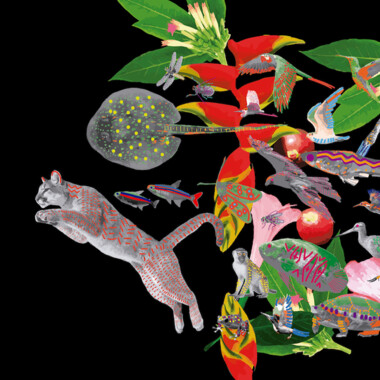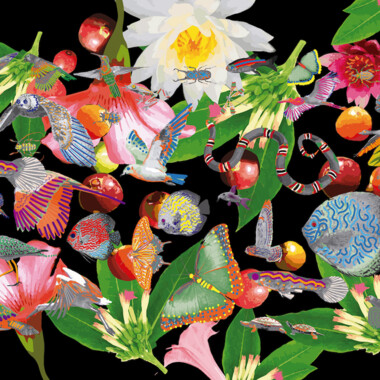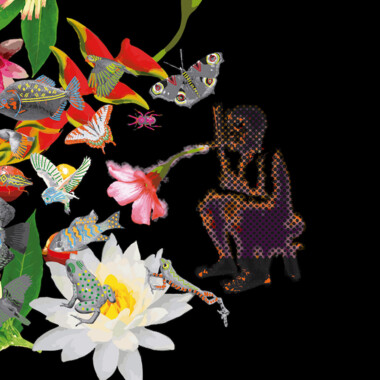


KO'EYENE
Denilson Baniwa, Naine Terena, Gustavo Caboco Wapichana, Jamille Pinheiro Dias
PERFORMANCES | INSTALLATIONS | WORKSHOPS | FILMS | CONCERTS
Click here for the map of the theatre park!
Ko’eyene brings together Indigenous artists from diverse South American peoples and regions to Braunschweig to encourage intercultural dialogue that will be shaped by themselves. In the Theatre park, this gathering will serve as a site of solidarity and collective action to address shared challenges of our time and to advocate for Indigenous rights and sovereignty on a transnational stage.
Rooted in the variety of tree species that surround the Staatstheater Braunschweig in the Theatre and Museum Park, Festival Theaterformen 2024 invites you on a journey through the tapestry of time. Inspired by the Terena Indigenous people's term "Ko'eyene", meaning "today", we want to think together about time beyond a chronology. The linear conception of time prevalent in Western thought will be disrupted and alternative temporalities that encompass the past, present, and future simultaneously, will unfold. Ko'eyene celebrates this interconnectedness, and encompasses all beings who traverse the park both human and non-human. How can we pose the question of the past and the future while things and beings exist in the here and now? What unique perspectives do the individual trees in these parks open up for us?
The curators of the Ko'eyene program are Denilson Baniwa, Naine Terena, Gustavo Caboco Wapichana, and Jamille Pinheiro Dias. The Indigenous artists and collectives they have invited not only show interdisciplinary artistic works that reflect ancestral knowledge and ongoing struggles against colonial legacies, but also allow us to practice this knowledge. The interdisciplinarity is manifested in the diverse facets of their practices, which range from performance, installations, ceramics, photography, video projection, and basketry – they encompass the material culture and technology of different Indigenous communities. The artists come from the Baniwa, Terena, Wapichana, Macuxi, Shipibo-Konibo, Kadiwel, Karapotó, and Qom peoples. Their perspectives may stem from diverse cultural contexts, but they still resonate through their respective cosmologies, their shared struggles against extractivism, and the defense of traditional knowledge, practices, and territories.
The complete curatorial statement on Ko'eyene can be found via the following link: Curatorial statement
By and with Denilson Baniwa, Francy Baniwa, Francisco Baniwa, Lilly Baniwa, Gustavo Caboco Wapichana, Roseane Cadete, Wihtner FaGo & Chana Davila, Idjahure, Ziel Karapotó, Eskina Qom & Ema Cuañeri, Kaiwino Wiz, Dhoze Terena Kali Sini, Irineu Nje'a Terena, Naine Terena, Niara Terena, Jamille Pinheiro Dias and many more.
Denilson Baniwa was born in Barcelos, Amazonas, and belongs to the Baniwa peoples. He is a visual artist, communicator and activist for the rights of Indigenous peoples. He currently lives in Niterói, where he founded together with friends Rádio Yandê, an important Indigenous media outlet for communication. As an artist, he deals with the presence of Indigenous peoples in Brazil's history and seeks to broaden knowledge about Indigenous cultures and presence. He exhibited at the São Paulo Biennial (2023) and co-curated the Hãhãwpuá Pavilion at the Venice Biennial in 2024 together with Arissana Pataxó and Gustavo Caboco.
Naine Terena belongs to the Terena peoples and is a researcher, university professor, curator, artist, and art educator. Since 2012, she has been running the cultural enterprise "Oráculo comunicação, educação e cultura". It promotes actions in the socio-cultural market, aiming to offer goods and services that have a positive impact on their surroundings, seeking to co-create solutions to issues involving everyday life through communication, art, and culture.
Gustavo Caboco Wapichana, from the Wapichana peoples, works in the fields of visual arts, literature and cinema. His production unfolds in multiple languages, such as drawing, painting, textiles, installation, performance, photography, video, sound and text, constituting devices for reflection on the displacement of Indigenous bodies, the processes of (re)territorialisation and the production of memory. Among his most important exhibitions, he took part in the 34th São Paulo Biennial in 2021. In 2024, he co-curated the Hãhãwpuá Pavilion at the Venice Biennale with Arissana Pataxó and Denilson Baniwa.
Jamille Pinheiro Dias is a lecturer and director of the Centre for Latin American & Caribbean Studies at the University of London. Her research focuses on Amazonian cultural production, environmental humanities, Indigenous arts and translation issues related to Latin America, with a focus on Brazil.
Production credits
Graphics Denilson Baniwa
KO’EYENE is funded by the German Federal Cultural Foundation, funded by the German Federal Government Commissioner for Culture & Media.